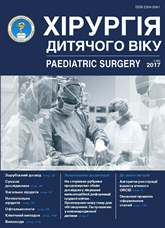Surgical treatment of congenital jejunoileal obstruction in newborns
DOI:
https://doi.org/10.15574/PS.2017.55.70Keywords:
congenital jejunoileal obstruction, anastomosis, stoma, newbornAbstract
Rationale. According to the current literature, the issue of rational approaches for the surgical treatment of neonates with congenital jejunoileal obstruction remains controversial.Objective: to investigate the efficacy of different types of surgical interventions and their impact on outcomes in newborns with jejunoileal obstruction.
Materials and methods. A retrospective analysis of medical records of 35 infants with jejunoileal obstruction was performed. To investigate the impact of different types of surgery on treatment results, all patients were divided into two groups. The children with jejunoileal obstruction, who had primary anastomosis of the small intestine during surgery were included into the 1st group (n=17). Into the 2nd group the infants who underwent the different types of intestinal stomas during primary surgery (n=12) were enrolled. The patients who had jejunoileal obstruction associated with gastroschisis (n=6) were excluded from the study.
Results. No significant difference between the diameters of the proximal and distal ileac segments among the children from the studied groups found (P>0.05). Children who underwent different types of intestinal stomas during the primary sugery had a greater incidence rate of sepsis, the significantly longer parenteral nutrition (P<0.05) and the time of conversion to the full enteral nutrition (P<0.05), as well as duration of hospitalization (P<0.05). The employment of ostomy did not lead to improvement of clinical outcomes and mortality reduction.
Conclusions. The primary anastomosis of the small intestine is the best method of surgical treatment of jejunoileal obstruction in newborns. However, the employment of intestinal ostomy does not improve outcomes.
References
Amidhonova SA. Kriterii vyibora sposoba sozdaniya anastomozov u novorozhdennyih s tonkokishechnoy neprohodimostyu: dis. … kand. med. nauk.
Santosh B Kurbet, Patil HS, Dhaded SM et al. (2012). Apple peel jejunal atresia: Successful management of a rare case. Journal of the Scientific Society. 39; Is 1. https://doi.org/10.4103/0974-5009.96470
Holcomb III GW, Murphy JP, Ostlie DJ. (2014). Ashcraft’s Pediatric Surgery. 6th Ed. Philadelphia: Еlsevier saunders: 1040.
Wax JR, Hamilton Th, Cartin A et al. (2006). Congenital Jejunal and Ileal Atresia Natural Prenatal Sonographic History and Association With Neonatal Outcome. Ultrasound Med. 25: 337–342. https://doi.org/10.7863/jum.2006.25.3.337
Stollman TH, de Blaauw I, Wijnen MH et al. (2009). Decreased mortality but increased morbidity in neonates with jejunoileal atresia; a study of 114 cases over a 34 year period. J Pediatr Surg. 44: 217–221. https://doi.org/10.1016/j.jpedsurg.2008.10.043; PMid:19159746
Eltayeb AA. (2009). Different Surgical Techniques in Management of Small Intestinal Atresia in High Risk Neonates. Pediatr Surg. 5: 315.
Grosfeld JL, O’Neil JJr, Coran AG. (2006). Jejunoileal Atresia and Stenosis. Coran AG (editors). Pediatric Surgery. 6th ed, Vol 2. Philadelphia: Mosby Elsevier: 1269–87.
Dalla Vecchia LK, Grosfeld JL, West KW et al. (1998). Intestinal atresia and stenosis: A 25-year experience with 277 cases. Arch Surg. 133: 490–496. https://doi.org/10.1001/archsurg.133.5.490; PMid:9605910
Piper HG, Alesbury J, Waterford SD et al. (2008). Intestinal atresias: factors affecting clinical outcomes. J Pediatr Surg. 43(7): 1244–1248. https://doi.org/10.1016/j.jpedsurg.2007.09.053; PMid:18639676
Wit J, Sellin S, Degenhardt P et al. (2000). Is the Bishop Koop anastomosis in treatment of neonatal ileus still current? Chirurg. 71; 3: 307–310. https://doi.org/10.1007/s001040051055; PMid:10789048
Baglaj SM, Czernik J, Koryszko J et al. (2001). Natural history of experimental intestinal atresia: Morphologic and ultrastructural study. J Pediatr Surg. 36: 1428–1434. https://doi.org/10.1053/jpsu.2001.26392; PMid:11528622
Nusinovich Y, Revenis M, Torres C. (2013). Long-term outcomes for infants with intestinal atresia studied at Children’s National Medical Center. J Pediatr Gastroenterol Nutr. 7(3): 324–329. https://doi.org/10.1097/MPG.0b013e318299fd9f; PMid:23666458
Puri P, Fujimoto T. (1988). New observations on the pathogenesis of multiple intestinal atresias. J Pediatr Surg. 23: 221–225. https://doi.org/10.1016/S0022-3468(88)80726-7
Downloads
Issue
Section
License
The policy of the Journal “PAEDIATRIC SURGERY. UKRAINE” is compatible with the vast majority of funders' of open access and self-archiving policies. The journal provides immediate open access route being convinced that everyone – not only scientists - can benefit from research results, and publishes articles exclusively under open access distribution, with a Creative Commons Attribution-Noncommercial 4.0 international license(СС BY-NC).
Authors transfer the copyright to the Journal “PAEDIATRIC SURGERY.UKRAINE” when the manuscript is accepted for publication. Authors declare that this manuscript has not been published nor is under simultaneous consideration for publication elsewhere. After publication, the articles become freely available on-line to the public.
Readers have the right to use, distribute, and reproduce articles in any medium, provided the articles and the journal are properly cited.
The use of published materials for commercial purposes is strongly prohibited.

